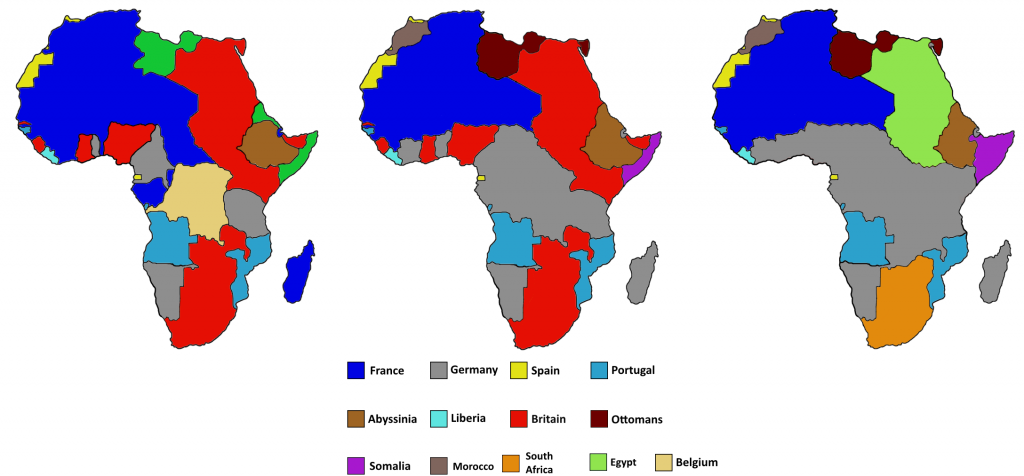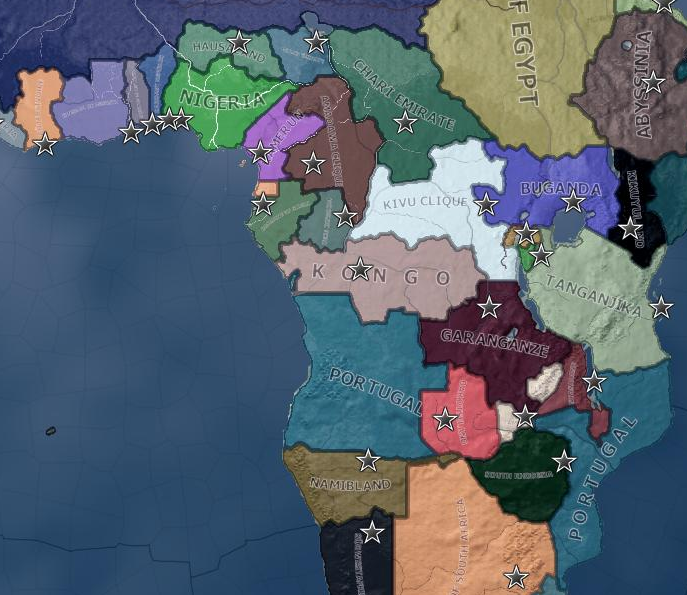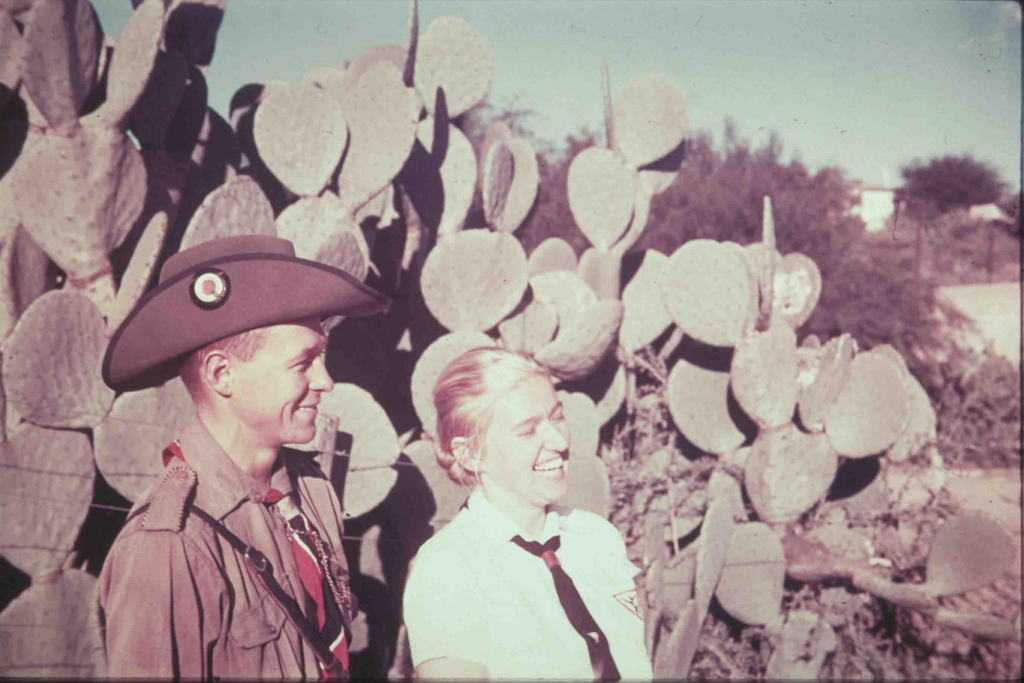This article is the first in a series of deep dives into alternative historical depictions of Africa and Colonialism in video games, primarily games by Paradox Interactive. In many popular Hearts of Iron IV mods, Germany controls large swathes of Africa as colonies: Mittelafrika. How would this colonial entity operate, and could it even exist the way it does in those mods?
Hearts of Iron IV: Kaiserreich
Hearts of Iron IV, the World War 2 simulation game of today’s topic, features a variety of total conversions that take place in alternate worlds, the most popular of which is Kaiserreich: Legacy of the Weltkrieg. In Kaiserreich, Germany emerges victorious from the Great War and is able to fulfill all its war aims from the Septemberprogramm. For Africa, this means that the British and French colonies are to be absorbed into a new entity under German control called Mittelafrika.
So what is a Mittelafrika, anyway?
Germany’s unification happened a short 13 years before the Congo conference in Berlin, which saw Europeans divide the hinterland of the African continent among themselves. Germany had thus far relied on expeditious individuals such as Karl Peters who had acquired land in East Africa on his own in the 1850s. When the German chancellor Otto von Bismarck officially created a charter company to give these endeavours government support an era of untold prosperity paired with constant violent repression ensued in the 1910s. Colonialism was sold at home, both figuratively as a romantic adventure and literally by business savvy mid-rank bureaucrats in the civil service who wanted to make a serious profit. Subsequent historians would commend German colonialism in those years as “an engine of modernization with far-reaching effects for the future.” At the same time, German colonialism had to contend with an African population that was highly resistant to European rule and with a widespread practice of slavery in their biggest colonial regions. The German administration often opted to fight fire with fire, which only made things worse. Uprisings within German African territory were quelled by the native Askari regimes, pitting Africans against each other.
As German colonial expansion continued and now enjoyed government support, the adventurers that initiated it made several attempts to connect Germany’s imperial holdings by purchasing land in central Africa. Two explorers, named Paul Reichard and Eduard Schulze, tried to buy the southernmost region of the Belgian Congo for Germany. Both offers were rejected by the Belgian government. An exchange of territory in Cameroon between France and Germany also took place in 1911, trading what is now southern Chad for the area known as Neu-Kamerun.
It would not be until World War One when the concept of a contiguous zone to connect all German colonies in Africa was drafted. State secretary of the German colonial office Wilhelm Solf created the “Mittelafrikaprojekt” in August and September of 1914 which boiled down to the distribution of the African colonies of France, Belgium and Portugal, The new, closed Central African colonial empire of Germany would encompass the following areas: Angola, the northern half of Mozambique, the Belgian Congo, with the Katangas copper mines as the most valuable individual object, French Equatorial Africa up to the level of Lake Chad, Dahomé and the area south of the Niger arc up to Timbuktu. This project of creating a coherent Central African colonial empire remained, in some areas still greatly expanded, from then on fundamentally part of the official German war aims.
Over the course of the war German foreign policy makers would adapt the plans for Mittelafrika to include several French African territories but the general belief was that war aims in Africa were of secondary importance to those in Europe, as victory over France and Britain would lead naturally to a situation where Germany could demand whatever it wanted. For Germany, colonies were more of a showcase and an expression of its (world) power. Mittelafrika would serve a similar role to Germany as India did to Britain.
Kaiserreich’s Mittelafrika
In Kaiserreich, the full extent of Germany’s war aims during WW1 is achieved. As a consequence, Africa now looks like this;
It should be noted that Germany did not immediately seize all of these territories it holds in this universe’s 1936. Rather, the expansion of Mittelafrika happened in three stages;
In stage 1 we see the borders of Africa before the start of WW1. Stage 2 is in 1921, when Kaiserreich’s Great War ends and the Peace with Honour, an alternative version of the Treaty of Versailles, is signed. Germany annexed the French and Belgian African territories during this time but as the peace treaty stipulated that Britain and Germany have an armistice their African colonies remain untouched. Mittelafrika’s bureaucracy then develops for the next 4 years until 1925, when a radical left-wing revolution takes place in Britain. The British African territories, left with little other choice, sign themselves over as temporary protectorates under Mittelafrika until responsible government in the home isles can be restored.
This is how we arrive at our big blob of land governed by, of all people, Hermann Göring. To briefly explain the dev team’s reasoning behind placing a nazi in charge of most of central Africa; Kaiserreich, being in development for over 5 years now, has always had a difficult time placing controversial German political figures into their scenario. These people were influential since before the point of divergence of the mod, so a solution had to be found that put them somewhere they had little to no sway over German politics. The intitial solution to this was to put them all in Africa, where they could only harm Africans and not Germans. It goes without saying that this was a very problematic solution that only moves the problem somewhere else, so over the years an effort has been made to simply write nazi politicians out of the lore altogether. Göring is one of the last remaining pieces of this old approach to “dealing with” nazis in Kaiserreich.
The government structure of the colony is the result of a rapid and chaotic expansion of several different pre-existing bureaucracies, on top of an essentially feudal system of protectorate treaties between the European administration of a colony and local native chiefs or kings. The man on top who answers to Berlin is that Staathalter, under him are five governors of Congo (Kongo). East Africa (Ostafrika), Equatorial Africa (Äquatorialafrika), Southern Africa (Südafrika) and West Africa (Westafrika). These governors in turn cooperate with the local powers who are beholden to agreements set up between them and the native representatives.
For both the convenience of the German administration and out of a sheer inability to affect so many different power structures, the Staathalters between 1921 and 1936 have taken a laissez-faire approach towards governing Mittelafrika. The areas formerly held by Britain, Belgium and France all have maintained their distinct cultural and social setups and the hundreds of protectorate kingdoms have even more heterogeneous landscapes and ideals. The old guard within the bureaucracy of Mittelafrika as well as the small clique of reformists led by Theodor von Hassel wants to maintain this diversity of rulership while also extending a limited suffrage to white settlers and African dignitaries. Göring on the other hand leads a clique of centralisers that want to streamline the administration to override local powers at will so that the colony can become more profitable. Resolving this conflict between Göring and the rest of the administration as well as dealing with an insurgency funded by Portugal on their shared colonial border is the main focus of your typical Mittelafrika game. Göring himself is usually removed from office on account of embezzlement of colonial funds, but can also declare himself the sovereign ruler of German Africa by declaring the rule of those hundreds of local native rulers illegitimate.
Naturally, this does not tend to go well for him. In the event that Göring or any other Staathalter destabilizes the colony too much, the chain of command will break down and Mittelafrika will collapse. The various states that emerge from this will battle for local power until they have consolidated their regions and European powers may then try to re-establish control over them. The Belgian administration in Katanga can, for example, retake most of the Congo if the Europeans are not overthrown there.
Namibia and South Africa can endeavour to retake all of British and German Africa respectively. Some players enjoy the extra challenge of going on a “Great Crusade” as either of these countries to restore colonial rule, but as of the last few updates Kaiserreich also has limited support for a campaign as a sovereign African power bloc. Liberia and Guarangze have had their African nationalist paths for quite some time already, with the recent addition being South Africa’s left-wing revolution path that leads to a majoritarian and socialist state that can dismantle German colonialism.
Germany’s African Bureaucracy
While there has of course not been a precedent for what a German takeover of central Africa might have meant for the common folk living there, there is an interesting case of the inverse happening from the 1920s to the 1930s; in 1919 Germany’s colonies were transferred to France and Britain as mandates by the Treaty of Versailles. Africans who were reliant on Germany for both their trade and position in the colonial hierarchy suddenly found themselves in a completely new situation built from the ground up by the Entente. Germans who were part of the colonialist movement that emerged in the Weimar period visited the former colonies and described how the French and British as well as the natives dealt with this transition. One such account is that of Bavarian writer and adventurer Senta Dinglreiter, who traveled to all of former German Africa to see how Africans and Germans were being treated there. (Additional information on Dinglreiter’s book can be found in my article for Innovative Research Methods)
Dinglreiter writes on Togo that it suffered an unemployment crisis followed by an emigration wave to the Gold Coast in late 1920. The French administration shut down German schools and missions and increased taxes by more than 20%. In early 1935 a riot broke out in Lome that saw all European shops looted, except the one remaining German shop. The rioters overwhelmed the small garrison of the French governor and demanded the release of (allegedly pro-German) political prisoners. Reinforcements from the neighboring French colony of Dahomey had to be brought in to quell the riot and a great crackdown on all supposed German sympathisers was organised. According to Dinglreiter this riot was a great humiliation to France as the Treaty of Versailles transferred Germany’s colonies away from them for the wellbeing of the native peoples. An uprising of this magnitude, calling for the restoration of German rule no less, flies completely in the face of the narrative that Germany was an “unjust coloniser”.
If the French had such a difficult time making their mandated colonies submit to their rule, it stands to reason that Germany would face many of the same issues on a much larger scale in the forming of Mittelafrika. This is why the 1921-1936 generation of Staathalters in Kaiserreich have by and large left the institutions of the British colonies alone. Forcibly removing English-speaking schools and missions from the protectorates, turning over land to German settlers and upsetting the balance between native rulers and local governors would lead to an unsustainable amount of instability and rebellion in favour of restoring British rule. Instead, the governors of Mittelafrika rule the rulers. The German administration installed itself on top of the French and British colonial bureaucracy and merely redirects their economies to Berlin.
Perhaps this is the only way such a monster of a colony like Mittelafrika could ever work. The official Kaiserreich wiki states that the territory contains around 52 million people. The geographic region itself is large enough to fit roughly two-thirds of China in it. It is a real testament to the profound effects of colonialism on the mind that so many people in such a massive area could be controlled by such a tiny amount of Europeans on the ground. A large-scale uprising against colonialism on account of one event such as with Göring may not be all that plausible but Kaiserreich’s leftist and internationalist countries have had small updates pertaining to their commitment to anti-colonialism and aiding Africans against the domination of Germany on the continent.

Jochem ‘Guthixian’ Scheelings is an MA student in African Studies at the University of Leiden and Intern at VALUE. He is aiming to specialise on crossing the boundaries between gaming and academia in his own field of expertise and maintains a broad interest in all depictions of Africa in video games. His speciality is immersive historical simulators by Paradox Interactive. Tweet him at @Guthixian_VALUE





